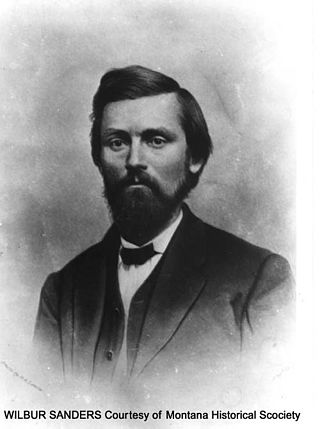
Montana is a landlocked state in the Mountain West subregion of the Western United States. It borders Idaho to the west, North Dakota to the east, South Dakota to the southeast, Wyoming to the south, and the Canadian provinces of Alberta, British Columbia, and Saskatchewan to the north. It is the fourth-largest state by area, but the eighth-least populous state and the third-least densely populated state. Its capital is Helena, while the most populous city is Billings. The western half of the state contains numerous mountain ranges, while the eastern half is characterized by western prairie terrain and badlands, with smaller mountain ranges found throughout the state.

Virginia City is a town in and the county seat of Madison County, Montana, United States. In 1961 the town and the surrounding area were designated a National Historic Landmark District, the Virginia City Historic District. The population was 219 at the 2020 census.

Deer Lodge is a city in and the county seat of Powell County, Montana, United States. The population was 2,938 at the 2020 census.

Charles Marion Russell, also known as C. M. Russell, Charlie Russell, and "Kid" Russell, was an American artist of the American Old West. He created more than 2,000 paintings of cowboys, Native Americans, and landscapes set in the western United States and in Alberta, Canada, in addition to bronze sculptures. He is known as "the cowboy artist" and was also a storyteller and author. He became an advocate for Native Americans in the west, supporting the bid by landless Chippewa to have a reservation established for them in Montana. In 1916, Congress passed legislation to create the Rocky Boy Reservation.

The Judith Mountains are located in central Montana in the Central Montana Alkalic Province in Fergus County, just to the northeast of Lewistown, Montana.

Wilbur Fisk Sanders was a United States senator from Montana. A leading pioneer and a skilled lawyer, Sanders played a prominent role in the development of Montana Territory and the state's early political history.
C. M. Russell Museum Complex is an art museum located in the city of Great Falls, Montana, in the United States. The museum's primary function is to display the artwork of Great Falls "cowboy artist" Charles Marion Russell, for whom the museum is named. The museum also displays illustrated letters by Russell, work materials used by him, and other items which help visitors understand the life and working habits of Russell. In addition, the museum displays original 19th, 20th, and 21st century art depicting the American Old West and the flora, fauna, and landscapes of the American West. In 2009, the Wall Street Journal called the institution "one of America's premier Western art museums." Located on the museum property is Russell's log cabin studio, as well as his two-story wood-frame home. The house and log cabin studio were designated a National Historic Landmark in 1965, and added to the National Register of Historic Places in 1966. In 1976, the listing boundaries were amended to account for moving the house.

The following works deal with the cultural, political, economic, military, biographical and geologic history of pre-territorial Montana, Montana Territory and the State of Montana.
Hezekiah Lord Hosmer II was a lawyer, judge, journalist, and author.
Barry H. Landau is a noted thief of presidential artifacts, collector of presidential artifacts, author, and "self-styled 'America's Presidential Historian'". In July 2011, Landau's associate, 24-year-old Jason Savedoff, was seen taking a document out of a library. After an investigation and various searches, Landau and Savedoff were "charged with stealing valuable historical documents from the Maryland Historical Society and conspiring to steal documents from other archives." After pleading guilty, Landau was sentenced to seven years' imprisonment in June 2012.
The Ravalli County Museum in Hamilton, Montana, is operated by the Bitter Root Valley Historical Society (BRVHS) in order to acquire, preserve, and interpret the historical and cultural heritage of the Bitter Root Valley and the inhabitants of Ravalli County, Montana. United States. The Museum is open year-round and features three main focal points: local history, natural history and art.
The history of vigilante justice and the Montana Vigilantes began in 1863 in what was at the time a remote part of eastern Idaho Territory. Vigilante activities continued, although somewhat sporadically, through the Montana Territorial period until the territory became the state of Montana on November 8, 1889. Vigilantism arose because territorial law enforcement and the courts had very little power in the remote mining camps during the territorial period.

Granville Stuart was an American pioneer, gold prospector, businessman, civic leader, vigilante, author, cattleman and diplomat who played a prominent role in the early history of Montana Territory and the state of Montana. Widely known as "Mr. Montana", Granville's life spanned the formative years of Montana from territorial times through the first 30 years of statehood. His journals and writings have provided Montana and western historians unique insights into life in the Northern Rocky Mountains and Great Plains during the second half the 19th century.

The Society of Montana Pioneers was founded on September 11, 1884, in Helena, Montana, to honor and document the histories of Montana pioneers who were resident in the territory at the time it became a Montana Territory, May 26, 1864. In 1909, the society changed its membership rules to admit pioneers who were resident the territory prior to December 31, 1868. In 1899, the society boasted 1536 active members out of a one time total of 1808. The society did not consider individuals who were assigned to Montana on military duties, individuals who were deemed outlaws such as Henry Plummer of Bannack, or Indians as eligible for membership in the society.
Stuart's Stranglers was a well-known vigilante group in Montana that was founded by wealthy ranchers in 1884 and led by Granville Stuart in response to widespread livestock theft at that time. They were also less commonly known as the "Montana Stranglers."
The Montana Stockgrowers Association (MSGA) is a non-profit membership organization that works on behalf of Montana cattle ranchers.

Brian Anthony D'Ambrosio is an American journalist and author. In 2023, he was indicted for theft from the Montana Historical Society of objects of cultural heritage, including archival documents such as letters from Nancy Russell, wife of artist C.M. Russell. He was arrested after he attempted to sell stolen items he had placed for sale on eBay to an undercover FBI agent. He was convicted in 2024 and sentenced to six months in federal prison.

The Montana State University Archives and Special Collections, also known as the Merrill G. Burlingame Archives and Special Collections, is located in Bozeman, Montana. The archives is on the second floor of the Renne Library on the Montana State University-Bozeman campus and consists of materials relating to the history of the American West, trout and salmonids, the Greater Yellowstone Ecosystem and other topics.














